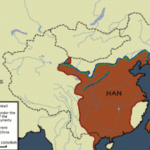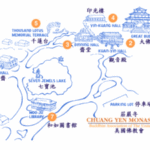Romance of the Three Kingdoms is known to many Americans a video game with either of that title or Dynasty Warriors. What most people don’t know is that these games are based on one of the oldest Chinese novels to date. First believed to be written in China by playwright Lo Kuan-chung in the late fourteenth century, the Romance of the Three Kingdoms is an epic historical fiction novel that follows three kingdoms that rival each other in order to unify all of China right after the downfall of the Han Dynasty. The novel first came to print in 1522 and was translated by C.H. Brewitt-Taylor in the mid 1920’s, which remains to be the present copy to this day and is published by Tuttle Co. Inc. The novel is extremely long and is therefore compiled into two volumes, Romance of the Three Kingdoms Vol. I and Romance of the Three Kingdoms Vol. II. However, the story itself was meant to be read continuously as the end of Vol. I has no resolution and is continued immediately in Vol. II. The story was separated because of sheer size.
There are many main characters in the Romance of the Three Kingdoms, however the main focus is on the hero, Liu Pei, who is a distant relative of the reigning family. The story opens up with the decline of the Han Dynasty, the ruling dynasty of all of China for the past 400 years. As the royal throne begins to crumble and lose power, a rebellious cult arises that brings together wonderful and terrible generals to fight off the rebellious menace. This sets the stage for the heroes of the Han army to make a name for themselves and to gain power. As the story unfolds over many, many chapters, the throne eventually loses all power and is basically controlled by one of its ministers, a former hero of the rebellions, T’sao T’sao. He ends up being the villain of the story as he forms the Wei kingdom that manipulates the throne and the Emperor for personal gain.
The hero, Liu Pei, is also the head of another kingdom, the Shu kingdom. Coming from humble backgrounds and being of virtuous nature, Liu Pei and his sworn brothers are committed to restoring the Han Dynasty to all its former glory. Liu Pei, however, is sometimes too virtuous to be a military leader as this becomes the cause of some of his defeats early in the story. for the good first half of the first volume, Liu Pei does not win a single victory but is defeated time and time again, mostly because he has no land to call his own. Eventually, he finds a great strategist, probably the best in the world, by the name of Chuko Liang. This changes the tides as LIu Pei sets forth seemingly invincible in all aspects of war.
The final kingdom, the Wu kingdom, is mostly run by Sun Chuan for most of the story. In the beginning however, it starts off with Sun Chian, Chuan’s father, and eventually the kingdom is passed down from him to his older brother, Sun Pe, and finally to himself due to unfortunate events. The Wu kingdom is known for their naval abilities and are basically caught in the middle of the war for Wei and Shu. In the course of the Romance of the Three Kingdoms, Wu ends up helping both Wei and Shu countless times as they’re just basically trying to survive and not be taken over by either kingdom.
The general storytelling is not in the conventional sense as the battles are described in one or two sentences. There is very little detail in the actual warfare itself. Typically, a battle is described as thus: So-and-so came out to challenge so-and-so. They fought a number of bouts and so-and-so retired; it was a victory for so-and-so. There are on rare occasions where there is more detail but do not expect some extravagant wording that will make your imagination actually see the battle. The writer is more focused on the outcome of the battle and how that outcome was reached instead of what actually happens in the battle. Lo Kuan-chung may from time to time say that someone got their head cut off or they were sliced in two, but for the most part he leaves those details out unless they are important. An example of this would be if a general were to get injured; Lo Kuan-chung would mention that the general was shot in the arm with an arrow, or they were shot in the eye with an arrow, or something of that sort.
As mentioned before, the focus of the storytelling is really with the outcome of the battles and the way those outcomes are reached. If anything, this novel isn’t a novel of war but of strategy as each ruler consults their advisors before any battle and every advisor tries to out-think their opponent’s advisor, much like a game of chess. Some of the strategies are really profound and quite fun to read but by the end of the first volume, you begin to realize that almost all the strategies that are offered are very similar: duel, pretend to lose, draw the enemy away from their camp, ambush them, and set their camp on fire. If someone is sieging a castle, the strategy would go as thus: either flood the castle or starve them, then leave one gate undefended to let the occupants leave and set an ambush along the path to cut them off. As repetitive as these strategies may be, there are finer details that can be appreciated. For the larger battles, there is the use of spies, ruses, and more extravagant strategies along with the typical fire attack.
An aspect of the novel that could be a major hindrance to many readers is the names of the characters portrayed. For one, some characters have two or three different names that the author uses at odd times. For example, Liu Pei is known as Liu, Liu Pei, Yuan-te, the First Ruler, and the Imperial Uncle. There are many other characters with the name Liu and Yuan, and there are other Imperial Uncles mentioned as well. Another reason names are hard is because a lot of them are spelled the same or look extremely similar. For example, there is a Huang Chuan and a Huang Chuang; there is a Meng Ta and a Mang Ta; there is Hsu Chu and Hsu C’hu. The names can really confuse readers but if they are careful it isn’t too hard to follow. Also, keeping in mind that the main characters are really the only names you really need to remember help as well. Aside from the similar names, some words are not translated from Chinese and oftentimes are not explained as to what the meaning is. This usually happens with titles and thus does not really hinder the understanding of the story.
Another aspect that make reading the novel hard is the fact that there are many spelling mistakes as well as grammatical errors as well. Sometimes, the word “and” is spelled without the “d”. As far as grammar goes, sometimes quotations are placed in the wrong spots and periods and commas are missing in other places. These are easily overcome if read carefully, but can really confuse you if you’re not paying careful attention.
The story itself is very fascinating, even if there are these hardships. The flow of the story is very fluid and tells every well. The strategies, wars, and reasonings of the three rules are so interesting that it’s really hard to put the book down. The novel also gives insight to some of the customs of ancient China such as proper warfare and respecting of leaders, a very different outlook than Western culture. The first volume is mainly consistent of only war and the beginning of the second volume finishes these wars and becomes very political. During this time, it does get a bit slow as there are a lot of speeches by court members, but the wars start up again which picks up the pace of the story. The novel doesn’t just cover the exploits of the three rules: Liu Pei, T’sao T’sao, and Sun Chuan, but instead goes beyond them to the generation after as it finishes with how the Three Kingdoms come to an end and how China is reunited once again.
The Romance of the Three Kingdoms is definitely a challenging book, but is really a hidden treasure as most people in Western culture do not know about it. Mainly being a popular book in the Asian countries, it is a great book for those that enjoy historical fiction books with a twist of fantasy or for those that enjoy war/strategy novels. Also, for parents that have kids that spend countless hours playing either the Dynasty Warriors or Romance of the Three Kingdoms video games, this would be a great book to recommend to your kids as they are sure to be interested to know that the games are based on these books. Each volume is about 600-700 pages but there are abridged versions available as well. This is a great book and is highly recommended for anyone looking for something different to read.
If you really enjoyed the books, the video game Dynasty Warriors 5 is also very recommended as all the events and battles are taken directly from the novel. It’s also worth mentioning that a movie is in the works with some top names in Asian cinema, such as Ken Watanabe (Last Samurai, Batman Begins), Chow Yun Fat (Replacement Killers, Bulletproof Monk), and Zhang Zi Yi (Crouching Tiger Hidden Dragon, House of Flying Daggers).
Rating: 9/10




